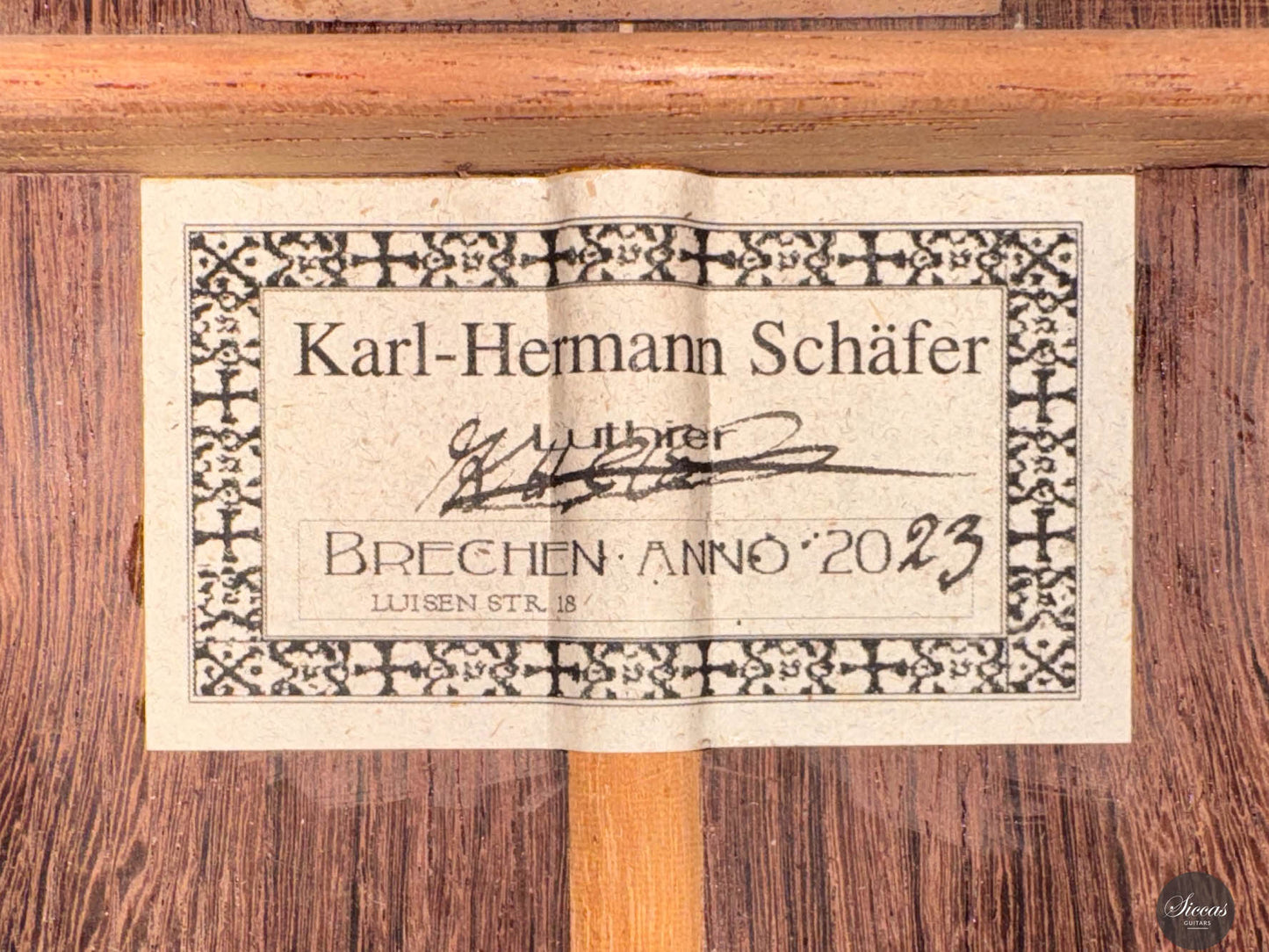Karl-Hermann Schäfer - 2023 - Santos Hernandez
Karl-Hermann Schäfer - 2023 - Santos Hernandez
Details
Details
Overview
Overview
Shipping important note
Shipping important note
Delivery times are typically reliable and most instruments arrive within the estimated timeframe.
Should any unexpected delay occur, our team will keep you informed and provide support at every step. For all shipping details and exceptions, please see our Shipping Policy.
Details about GPSR
Details about GPSR
























Video overview


More details about the guitar
About the luthier
Karl-Hermann Schäfer started making guitars in 1966. He did his apprenticeship under the guidance of master guitar maker Ernest Köröskeny and later studied under master guitar maker Dieter Hopf. After having worked in Hopf’s workshop from 1971 to 1994, he opened his own in Oberneisen and moved to Niederbrechen, Germany, five years later. Karl-Hermann Schäfer has specialized in making the most wonderful replicas one could wish for. These instruments are not only well built, but they also offer the very authentic sound of master instruments of the past.About the guitar
Karl-Hermann Schäfer is undoubtedly one of the few modern luthiers with a profound understanding of early 20th-century Spanish guitar making, particularly the work of Santos Hernández, Antonio de Torres, and other iconic masters. This particular guitar is inspired by the guitars of Santos Hernández, and it reflects Schäfer’s dedication to authenticity, nuance, and historical detail. Tonally, the guitar is strikingly close to a Santos Hernández from the early 1930s, with a similarly angled headstock and an overall playing feel that captures the soul of the original. The instrument delivers a deep resonance between E and F, giving it a distinct “old world” character, while the basses are rich and profound, and the trebles sing with warmth, sustain, and clarity—a rare combination that few luthiers can achieve. It also boasts remarkable evenness across the entire fingerboard and register, making it not only historically accurate but also a highly playable and expressive concert instrument. Internally, the spruce soundboard is supported by a 7-fan bracing system, with five symmetrical braces and two outer braces connected by small diagonal bars, forming subtle “L”-shaped figures. Similar pattern can be found in 1935 Santos Hernandez. As a pre-loved instrument, this guitar is in excellent condition, with only a few minor playing marks. It could easily be rated as near mint, and stands as a beautiful and faithful homage to one of the greatest luthiers of the classical guitar tradition.Regular care extends the life of the instrument
Even with careful use, a classical guitar may gradually change in appearance or respond to unstable storage conditions. Have a close look at your guitar regularly and be attentif to changes. If your instrument is suffering from its environement, it will let you know.
Protect Your Guitar: Handle with Care
Be mindful when touching your instrument with greasy or unwashed hands: any skin contact is a small attack on the varnish. Of course, a guitar is made to be played, but taking a few precautions helps preserve its beauty: wash your hands before playing, wear long sleeves, and avoid unnecessary direct skin contact with the body of the instrument.
Pro tip: Avoid playing with a button-up shirt, heavy jewelry, or a belt, as these can scratch the guitar. Also, make sure your guitar case is free of any objects that could damage the instrument during storage.
String care
A good habit to adopt is wiping down your strings briefly after each playing session. This small action significantly extends their lifespan and helps maintain a consistent, comfortable feel under your fingers.
Most importantly, clean strings are essential for keeping your instrument in tune. Corrosion, sweat, and dust can affect the uniformity of the strings and interfere with accurate tuning across the entire fingerboard.
Pro tip: If you're having trouble getting your guitar in tune, it might be time to change the strings. A useful test is to compare the pitch of the 12th fret harmonic with the fretted note at the 12th fret; if there's an unusually large gap between them, your strings may have lost their integrity and should be replaced.
Keep Your Shellac Finish Shining!
Got a guitar with a shellac (French polish) finish? Here's a simple trick: Take a clean microfiber cloth and gently breathe on the surface to create a light mist. Then, softly rub to remove fingerprints, sweat, and grease. That’s usually all it takes to keep it looking great, no products needed!
Pro tip: Every few years, treat your guitar to a check-up with a luthier to keep it in top shape.
Storing Your Guitar: Climate Matters
Your guitar can safely stay outside its case, as long as the surrounding environment maintains 42–55% humidity and a temperature between 18–25°C.
Keep in mind that humidity levels can still fluctuate inside the case, especially during seasonal changes.
- Too much humidity may cause overtightened strings and a dull tone.
- Too little humidity can lead to a bulging top, string buzz, or even cracks.
Avoid placing your guitar near radiators, air conditioners, or windows with direct sunlight.
Pro tip: Always close your guitar case while playing. This helps preserve a stable microclimate inside the case, so your instrument is protected the moment you put it back in.





















































